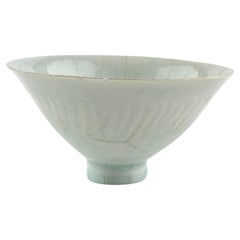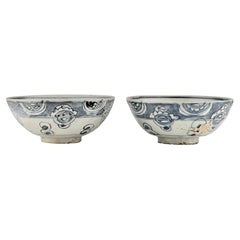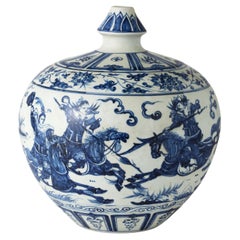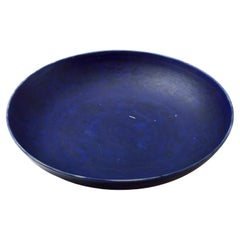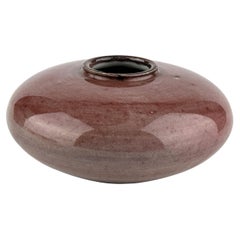AUA Oriental Art
to
294
189
58
49
42
35
20
19
18
12
5
3
2
1
A Qingbai Conical Bowl, Song Dynasty
Located in seoul, KR
This Qingbai bowl is made of fine white clay, covered with a translucent glaze tinged with a pale bluish hue. The exterior is subtly decorated with softly rendered lotus-petal (lianb...
Category
Antique 15th Century and Earlier East Asian Antiquities
Materials
Ceramic
Pair of Celadon Vases with Double Handles, Song-Yuan Dynasty
Located in seoul, KR
These tall-necked vases feature gently flared rims and double dragon-form handles on the shoulders, each suspending a large, free-moving ring. The surfaces are covered with a lustrou...
Category
Antique 15th Century and Earlier East Asian Antiquities
Materials
Celadon
Pair of Bowls from Shipwreck, Late Ming Era(16-17th century)
Located in seoul, KR
These shallow bowls feature stylized floral and wave motifs rendered in fluid cobalt brushwork beneath a clear glaze. The slightly everted rims and neatly cut foot rings are characte...
Category
Antique 17th Century East Asian Ming Antiquities
Materials
Ceramic
Rare Blue and White Jar with Cavalry Battle Scene, Early Qing Dynasty
Located in seoul, KR
The exterior is vividly decorated with a dynamic cavalry battle scene, rendered with exceptional precision and lifelike detail. The depiction of horses and soldiers, the folds of gar...
Category
Antique 18th Century East Asian Qing Antiquities
Materials
Ceramic
Large Rare Blue-Glazed 'Rockwork and Flowers' Dish, Early Qing dynasty
Located in seoul, KR
This piece is a large cobalt-blue glazed dish from the Qing Dynasty(Yuan-Ming Prototype). The entire surface, including the interior and exterior walls, is coated in a rich and deep cobalt blue glaze. Characteristic signs of prolonged submersion in a marine environment are visible, including subtle loss of gloss (especially in the central and end area), a slight tackiness on the surface caused by salt exposure, and abrasion in areas where the glaze is thinner—distinct indicators of a shipwreck-recovered ceramic.
The exterior wall features dark underglaze floral designs that create a unique sense of visual depth. The unglazed base reveals a white porcelain body, consistent with the typical kaolin clay from Jingdezhen used during the late Ming and early Qing periods. The rim is thin and carefully finished, and the overall proportions and decorative composition reflect a high degree of balance and refinement. It is one of the large pieces from our gallery’s Yuan-Ming Style from Qing Dynasty collection, reimagining ceramics from pre-Qing dynasties recovered from underwater.
Period : Qing Dynasty(Presumably Kangxi or Yongzheng Period)
Type : Dish
Medium : Blue glaze
Condition : Excellent
Provenance: Southeast Asia, South China Sea in early 2000s
Reference :
1) Christies Newyork 22 MAR 2018 - The Studio of the Clear Garden: Chinese Ceramics and Works of Art - Lot 604
(Price realised : USD 732,500 / Type : related - Ming style)
2) Sotheby's London 4 November 2020 - Imperial Porcelain – A Private Collection - Lot 19
(Price realised : GBP 75,600 / Type : related - Yuan style)
3) Asian Art Museum, San Francisco - Object number B60P88
(Type : related - Ming style)
4) Art Institute Chicago - Reference Number 1997.390 - Large Foliate Dish with Garden Rock and Plants
(Type : Closely related)
* Yuan-Ming Style from Qing Dynasty
During the Qing dynasty, many ceramics were produced that imitated the styles of the Ming and Yuan dynasties. This practice was not mere imitation but a creative endeavor to inherit and innovate upon past techniques and styles. Qing dynasty ceramicists mastered the exceptional techniques of Ming and Yuan ceramics and used them as a foundation to develop more advanced works. Particularly, Yuan dynasty blue and white...
Category
Antique 18th Century East Asian Qing Antiquities
Materials
Ceramic
Lang Yao Water Coupe, Qing Period
Located in seoul, KR
This ceramic piece features a low, rounded form with a narrow mouth, exemplifying refined simplicity and balance. The surface is covered in a rich, deep crimson glaze, likely derived...
Category
Antique 18th Century East Asian Qing Antiquities
Materials
Ceramic
Crackle Glazed Bowl, Qing Period
Located in seoul, KR
Rounded form, covered with a glaze of a pale grey and yellowish tone with brown network of crackles.
Period: Qing Dynasty or Song Dynasty
Type: Bowl
Medium: Crackle Glazed
Size : 9...
Category
Antique 18th Century East Asian Qing Antiquities
Materials
Ceramic
Blue and White Porcelain Meiping Vase with Peony Scroll, Ming Dynasty
Located in seoul, KR
This piece is presumed to be a blue and white porcelain meiping vase from the mid-Ming Dynasty. The entire body is decorated with arranged peony scrolls painted in underglaze cobalt blue. The vivid yet dark navy tone of the cobalt pigment suggests it may have been produced using pigment typical of the early to mid-Ming period.
The decorative bands, such as the cloud motifs and the lotus petal patterns, contribute to the overall sense of proportion and harmony. The intricate brushwork and density of the design indicate a skilled artisan’s hand. The balanced form and the shape of the foot provide clues for dating the piece.
Period: Mid-Late Ming Dynasty
Medium: Blue and White Porcelain
Type: Meiping
Size : 3.5cm(Mouth Diameter), 27cm(Height)
Provenance : Acquired in late 1990s from Hongkong
Reference : Sotheby's Paris 10 December 2019 - VASE EN PORCELAINE BLEU BLANC...
Category
Antique 16th Century East Asian Ming Antiquities
Materials
Ceramic
Blue and White Porcelain Vase with Figures, 19-20th Century
Located in seoul, KR
A porcelain meiping vase decorated in underglaze cobalt blue with scholar and attendant figures in a natural landscape. The finely crackled glaze and soft brushwork evoke a sense of ...
Category
Antique 19th Century East Asian Qing Antiquities
Materials
Ceramic
Rare Annamese Stoneware Bowls with Brown-Green Glaze, Vietnam, 14th–15th Century
Located in seoul, KR
This finely matched pair of Annamese stoneware bowls exemplifies the refined ceramic artistry of Đại Việt (medieval Vietnam) during the 14th to 15th century. Each bowl is delicately ...
Category
Antique 15th Century and Earlier Vietnamese Antiquities
Materials
Stoneware
Lower Xiajiadian Culture Tripod Li Jar, 2000–1500 BCE
Located in seoul, KR
This tripod jar, dating from 2000 to 1500 BCE, is attributed to the Lower Xiajiadian Culture, which flourished in Northeast China. It exemplifies the early ceramic craftsmanship of N...
Category
Antique 15th Century and Earlier Hong Kong Antiquities
Materials
Earthenware, Pottery
A Rare Longquan Celadon 'Peony' Vase Yuan-Ming Dynasty
Located in seoul, KR
This vase features a traditional vase coated with a clear and rich green celadon glaze. A fine network of crazing covers the surface. The neck is adorned with raised vine motifs, whi...
Category
Antique 15th Century and Earlier East Asian Ming Antiquities
Materials
Celadon
Celadon Bowl with Incised Lotus Patterns, Song Dynasty
Located in seoul, KR
Beneath the soft grayish-green glaze, incised lotus design emerges. The surface is adorned with flowing lines depicting lotus flowers and leaves, rendered in a refined carving techni...
Category
Antique 15th Century and Earlier East Asian Antiquities
Materials
Celadon
Pair of Rider Figures on Mythical Beasts Possibly from Qing Dynasty
Located in seoul, KR
Identical piece is housed in the Longhai Museum of Zhangzhou City. On October 7, 1989, it was appraised as a third-class cultural relic by the Cultural Relics Appraisal Team of the F...
Category
Antique 17th Century Hong Kong Qing Antiquities
Materials
Pottery
Pre Columbian Double-Spouted Anthropomorphic Vessel
Located in seoul, KR
This double-spouted vessel originates from the Peru and is distinguished by its sculptural anthropomorphic design. One of the chambers is shaped as a human figure with a triangular f...
Category
Antique 15th Century and Earlier Peruvian Pre-Columbian Vases
Materials
Pottery
Famille rose porcelain vase, 19-20th century
Located in seoul, KR
This porcelain vase, likely from the late Qing dynasty or early Republic period (late 19th to early 20th century), is a fine example of Famille-Rose (fencai) decoration. The body is ...
Category
Antique Late 19th Century Hong Kong Qing Antiquities
Materials
Ceramic, Porcelain
Copper Red Brushpot, Qing Dynasty, Kangxi Mark
Located in seoul, KR
This porcelain brush pot, crafted on a white body, is delicately decorated with copper red (hongcai 紅彩), depicting a figure in traditional attire amidst a landscape of pine trees, ro...
Category
Antique Early 18th Century East Asian Qing Ceramics
Materials
Copper
Pomegranate Shaped Copper Red Glazed Vase, Yuan-Ming Period
Located in seoul, KR
This piece is a small ceramic vessel with a distinctive silhouette modeled after a pomegranate, notable for its full, well-balanced curves. The mouth, reminiscent of the fruit’s caly...
Category
Antique 16th Century Hong Kong Ming Antiquities
Materials
Copper
Earthenware Ewer, Yi
Located in seoul, KR
This terracotta vessel was fired to a warm yellow-brown that shows subtle oxidation marks across the surface. Entirely unglazed, it retains a matte, tactile finish with fine pores an...
Category
Antique 15th Century and Earlier East Asian Antiquities
Materials
Earthenware, Pottery
$2,000
A Rare Blue And White Octagonal Box And Cover, Ming Dynasty Wanli Six-Character
Located in seoul, KR
Numerous similar octagonal blue and white boxes with Wanli, Jiajing marks are housed in prestigious museum collections. An example in the Tokyo National Museum is featured in Illustr...
Category
Antique 16th Century Hong Kong Ming Antiquities
Materials
Ceramic
Porcelain with transparent pale-bluish (qingbai-type) glaze, Yuan Dynasty
Located in seoul, KR
This piece is shaped like a lotus bud, featuring a gracefully undulating body and intricate geometric patterns. The neck is adorned with finely incised dense lines, adding visual var...
Category
Antique 15th Century and Earlier Hong Kong Antiquities
Materials
Ceramic, Porcelain
Funerary Model of a Granary, Han dynasty
Located in seoul, KR
Cylindrical vessel on three animal-shaped feet (dragon or snake), wall with profile grooves, roof. pottery with green lead glaze. "Iridescence" is observed in surface.
Period : Han...
Category
Antique 15th Century and Earlier Hong Kong Han Antiquities
Materials
Pottery
Pottery Tripod Vessel, Neolithic Period
Located in seoul, KR
The sturdy triangular legs, wide mouth, convex body, and diagonal incised patterns create a harmonious balance, showcasing a form that is both primitive and refined. Notably, the twi...
Category
Antique 15th Century and Earlier Hong Kong Antiquities
Materials
Earthenware, Pottery
Grey Tripod Granary Jar, Han dynasty
Located in seoul, KR
The vessel consists of a rounded cylindrical body, a gently curved upper section, and a small circular opening, suggesting that it was used for storing grain or valuable goods.
Thre...
Category
Antique 15th Century and Earlier Hong Kong Han Antiquities
Materials
Earthenware
Green Glazed Horse and Rider, Ming period(15-16th Century)
Located in seoul, KR
Statues of East Asian horse rider, featuring glazes in green, are set on rectangular base.
Period: Ming Dynasty
Medium: Green-glazed Pottery
Type: Figure
Condition : Good
Provenance : Acquired in early 2000s from Hongkong
* Ming Dynasty Glazed Pottery Figures
Ming Dynasty glazed pottery figures are renowned for their bold color palette, intricate detailing, and lifelike forms, distinguishing them from earlier traditions. These figures, which depict officials, warriors, animals, and mythical creatures, are characterized by high-gloss lead-based glazes in green, amber, ochre, and sancai (three-color) combinations. The thickly applied glaze pools in recesses, creating depth and enhancing sculptural details. With dynamic postures, expressive facial features, and meticulously rendered drapery, these figures reflect the period’s advancement in ceramic craftsmanship, offering a greater sense of movement and realism compared to the rigid and stylized forms of earlier dynasties.
A defining characteristic of Ming glazed...
Category
Antique 15th Century and Earlier Hong Kong Ming Antiquities
Materials
Pottery
A Rare Yue Celadon Cong-Shaped Vase, Western Jin Dynasty(3-5th C)
Located in seoul, KR
This vase is an exceptionally rare piece and likely the only known example of a Cong-shaped vase from the Jin Dynasty. While some experts may attribute this work to the Song Dynasty or later periods based on its form, it is, in fact, a much earlier creation from the 3rd to 4th century CE during the Jin Dynasty. It was imported from Hong Kong in the late 1990s and was acquired by our gallery as part of a collection that included other Jin Dynasty Yue celadon pieces.
The vase features a cylindrical form with a square (方形) design and geometric incised patterns. While these design elements became more refined and sophisticated during the Song Dynasty (960~1279), their origins trace back much earlier, as evidenced by Cong-shaped jade artifacts dating as far back as 2,500 B.C.E. Examples of these ancient jade Congs...
Category
Antique 15th Century and Earlier Hong Kong Antiquities
Materials
Celadon
A Zhejiang Porcelain Ewer, Northern Song Dynasty
Located in seoul, KR
The oviform body is divided into few lobes. All covered in a finely crackled pale olive-green glaze. The surface and glaze characteristics are definitive, confirming the authenticity...
Category
Antique 15th Century and Earlier Hong Kong Antiquities
Materials
Porcelain
A Longquan Celadon Five-spouted Jar, Northern Song Dynasty (960~1127)
Located in seoul, KR
The jar features a round body with well-proportioned four distinct tiers and a short, stable foot. The surface is coated in a deep green Longquan celadon glaze, showcasing the sprout...
Category
Antique 15th Century and Earlier Hong Kong Antiquities
Materials
Celadon
Five Green Glazed Pottery Attendant Figures, Ming Dynasty(1368-1644)
Located in seoul, KR
The three figurines in the back exhibit the typical form of attendants, wearing conical red hats and adopting poses where their right hands are either held in front of their chests o...
Category
Antique 15th Century and Earlier Hong Kong Ming Antiquities
Materials
Pottery
Four Green Glazed Pottery Attendant Figures, Ming Dynasty(1368-1644)
Located in seoul, KR
The first figure wears a short cap and takes a posture as if carrying something on the shoulder, possibly symbolizing a servant or a messenger.
The second figure wears a tall hat and...
Category
Antique 15th Century and Earlier Hong Kong Ming Antiquities
Materials
Pottery
Carved Bamboo Wooden Censer and Brush Holder, Republic Period
Located in seoul, KR
Left: Censer – A traditional tripod censer featuring intricate East Asian motifs and inscribed characters. The lid is adorned with delicate carvings, adding to its mystical ambiance....
Category
20th Century East Asian Antiquities
Materials
Bamboo
Carved Bamboo Incense Burners, Late Qing to Republic period
Located in seoul, KR
Each burner features a unique design with traditional pillar-shaped structures and intricate openwork carvings. The lids are adorned with delicate floral and nature-inspired motifs, ...
Category
Antique 19th Century East Asian Antiquities
Materials
Bamboo
A Large Gu Vase from Vung Tau Ship, Qing Dynasty Kangxi Era, Circa 1690
Located in seoul, KR
Finely painted landscape scenes in vertical panels, depicting mountains, rivers, pavilions, arched bridges, and scholar figures in flowing robes. The scenes are rendered in varying d...
Category
Antique 17th Century Vietnamese Qing Antiquities
Materials
Ceramic, Porcelain
Blue and White Vase from Vung Tau Ship, Qing Dynasty Kangxi Era, Circa 1690
Located in seoul, KR
The entire surface of the vase is adorned with elaborate chrysanthemum motifs, elegantly connected by flowing, curved stems, while the background's leaf patterns enhance its sense of...
Category
Antique 17th Century Vietnamese Qing Ceramics
Materials
Ceramic, Porcelain
Ginger Jar with 'Hehe Erxian' Pattern, Early Qing Dynasty(17-18th century)
Located in seoul, KR
The Hehe Erxian (和合二仙, Ho Ho Erh Hsien), Taoist immortals known for symbolizing harmony and union, are vividly depicted on this blue and white porcelain jar. Within the central medal...
Category
Antique 17th Century Hong Kong Qing Ceramics
Materials
Ceramic, Porcelain
Green-Glazed Pottery ‘Money Tree’ Base, Han Dynasty
Located in seoul, KR
This piece, directly referred to as a Money Tree, is a captivating work that embodies wishes for material prosperity. It takes center stage in the Asian collections of institutions s...
Category
Antique 15th Century and Earlier Hong Kong Han Antiquities
Materials
Earthenware, Pottery
A Large and Rare Straw-Glazed Pottery Amphora, Tang Dynasty
Located in seoul, KR
The ovoid shape suggests the influence from “amphora” of Greece and Rome, while the dragon-shaped handles allude to Persian and Central Asian metalwork. The ubiquitous dragon is a Ea...
Category
Antique 15th Century and Earlier Hong Kong Tang Antiquities
Materials
Pottery, Stoneware
A Straw-Glazed Pottery Figure of a man on Horseback
Located in seoul, KR
The rider is seated upright, wearing a smoothly draped robe with finely sculpted folds. The red markings on the garment surface are likely either soil deposits or remnants of pigment...
Category
Antique 15th Century and Earlier Hong Kong Tang Antiquities
Materials
Pottery, Straw
Two Straw-Glazed Pottery Figures of Court Male and Female
Located in seoul, KR
This pair of straw-glazed pottery figures represents a male and female court attendant, both elegantly attired in period fashion. The female figure wears a flowing robe with draped f...
Category
Antique 15th Century and Earlier Hong Kong Tang Antiquities
Materials
Pottery, Straw
A Large Straw Glazed Pottery Figure of a Solider
Located in seoul, KR
This well-modeled ceramic figure depicts a Scythian warrior in full armor, likely serving as a standard bearer. The warrior stands upright on a thin rectangular base, with clenched f...
Category
Antique 15th Century and Earlier Hong Kong Tang Antiquities
Materials
Straw
Two Cosmetic Box and a Square Box from Ca Mau Ship, Qing Dynasty, Yongzheng Era
Located in seoul, KR
1. Left Round Cosmetic Box : Circular form with flattened doomed cover, the covers with a medallion of simple stylised flowers surrounded by stylised lapp...
Category
Antique Early 18th Century Vietnamese Qing Antiquities
Materials
Ceramic
Lotus Pattern Dish From Ca Mau Ship Circa 1725, Qing Dynasty, Yongzheng Reign
Located in seoul, KR
This lotus dish from Ca Mau Ship was held in our gallery in three pieces(according to sizes). One was sold in 2024.
With radiating lotus-petal 8 panels painted with single flowers a...
Category
Antique Early 18th Century Vietnamese Qing Ceramics
Materials
Ceramic
Two Yixing Teapots and Covers
Located in seoul, KR
Both Yixing Zisha teapots appear to be modern-Republic era pieces. Yixing Zisha teapots are made from rare Zisha (紫砂) clay, which is exclusively mi...
Category
20th Century East Asian Antiquities
Materials
Pottery
$1,500 / set
Two Yixing Zisha Teapots and Covers
Located in seoul, KR
Both Yixing Zisha teapots appear to be modern to republic-era pieces. Yixing Zisha teapots are made from rare Zisha (紫砂) clay, which is exclusively...
Category
20th Century East Asian Antiquities
Materials
Pottery
$1,500 / set
Hexagonal Porcelain Vase with Landscape Decoration, Late Qing Dynasty
Located in seoul, KR
The vase has a hexagonal shape, with a structure that extends seamlessly from the rim to the base, creating a sense of visual stability. The neck features sculpted handles in the for...
Category
Antique 19th Century Hong Kong Qing Ceramics
Materials
Ceramic
Underglaze Blue and Copper Red Yuhuchunping, Late Qing Dynasty
Located in seoul, KR
This Qing Dynasty Yuhuchunping features a soft pale green glaze applied evenly across its surface, exhibiting fine crackles that enhance its aged character. The vase has a gracefully...
Category
Antique 19th Century Hong Kong Qing Ceramics
Materials
Ceramic
Ming Period Large Pottery Horse with Saddle (15-16th Century)
Located in seoul, KR
This Ming Dynasty painted pottery horse is depicted standing on a tiered rectangular pedestal. The horse has a well-proportioned body, with sturdy legs and a slightly arched neck. The eyes and muzzle are subtly outlined and incised.
The mane is sculpted with deep, parallel grooves. The tail is long and slightly curved left, extending downward. The saddle is prominently featured at the center of the horse’s back, detailed with a raised, rounded seat and an attached stirrup hanging down one side. The saddlecloth is textured with a crosshatch pattern, bordered by a row of carved fringe-like elements. The horse's legs display subtle musculature, and the hooves are clearly defined, with black pigment accentuating their edges.
The original painted pigments, including white, black, and ochre, are still visible, though faded in some areas. The black pigment highlights the mane, tail, and parts of the bridle, while the ochre tones accentuate the saddle and decorative elements.
Period: Ming Dynasty
Medium: Green, black, and ochre glazed Pottery
Type: Figure
Provenance : Acquired in late 1990s from Hongkong
Reference : Asian Civilisations Museum - Accession No. C-1384 / 1994-00441 - Ming Dynasty Figure of Horse
(Type : Closely Related)
* Ming Dynasty Glazed Pottery Figures
Ming Dynasty glazed pottery figures are renowned for their bold color palette, intricate detailing, and lifelike forms, distinguishing them from earlier traditions. These figures, which depict officials, warriors, animals, and mythical creatures, are characterized by high-gloss lead-based glazes in green, amber, ochre, and sancai (three-color) combinations. The thickly applied glaze pools in recesses, creating depth and enhancing sculptural details. With dynamic postures, expressive facial features, and meticulously rendered drapery, these figures reflect the period’s advancement in ceramic craftsmanship, offering a greater sense of movement and realism compared to the rigid and stylized forms of earlier dynasties.
A defining characteristic of Ming glazed pottery is its elaborate surface detailing, often achieved through raised relief elements and contrasting glazes. Equestrian figures, for example, feature carefully sculpted saddles, harnesses, and decorative embellishments, while human figures are adorned with intricate robes and headdresses. The large scale of these tomb figures, often more imposing than those from previous periods, underscores the increasing importance of funerary art during the Ming era. Unlike later Qing Dynasty figures...
Category
Antique 15th Century and Earlier Hong Kong Ming Antiquities
Materials
Pottery
Ming Period Large Pottery Horse with Saddle (15-16th Century)
Located in seoul, KR
The figure stands on a rectangular base. The horse is depicted in a poised stance, with strong, muscular legs and a slightly bowed head. The mane is carefully sculpted with deep, flowing grooves, adding a dynamic texture to the piece. The head features expressive details, including a well-defined muzzle, flared nostrils. The bridle and harness are delicately painted in faded green, contrasting against the creamy beige body. The saddle is adorned with intricate details, including decorative tassels and a textured pattern, indicative of the elaborate tack used in the Ming period.
Traces of original polychrome pigments in green, black, and ochre remain on the surface, hinting at the sculpture’s once-vibrant appearance. The weathered patina and areas of flaking paint add to its historical authenticity, reflecting centuries of age. The overall craftsmanship and detailing exemplify the Ming Dynasty’s refined ceramic artistry, making this piece a remarkable representation of of asian culture during this period.
Period: Ming Dynasty
Medium: Green, black, and ochre glazed Pottery
Type: Figure
Condition : Good(chips on the upper saddle.)
Provenance : Acquired in late 1990s from Hongkong
Reference : Asian Civilisations Museum - Accession No. C-1384 / 1994-00441 - Ming Dynasty Figure of Horse
(Type : Closely Related)
* Ming Dynasty Glazed Pottery Figures
Ming Dynasty glazed pottery figures are renowned for their bold color palette, intricate detailing, and lifelike forms, distinguishing them from earlier traditions. These figures, which depict officials, warriors, animals, and mythical creatures, are characterized by high-gloss lead-based glazes in green, amber, ochre, and sancai (three-color) combinations. The thickly applied glaze pools in recesses, creating depth and enhancing sculptural details. With dynamic postures, expressive facial features, and meticulously rendered drapery, these figures reflect the period’s advancement in ceramic craftsmanship, offering a greater sense of movement and realism compared to the rigid and stylized forms of earlier dynasties.
A defining characteristic of Ming glazed pottery is its elaborate surface detailing, often achieved through raised relief elements and contrasting glazes. Equestrian figures, for example, feature carefully sculpted saddles, harnesses, and decorative embellishments, while human figures are adorned with intricate robes and headdresses. The large scale of these tomb figures, often more imposing than those from previous periods, underscores the increasing importance of funerary art during the Ming era. Unlike later Qing Dynasty figures...
Category
Antique 15th Century and Earlier Hong Kong Ming Antiquities
Materials
Pottery
Yue Celadon Ewer, Late Tang-Northern Song Dynasty
Located in seoul, KR
This Yue ware celadon ewer features a gracefully rounded body that expands smoothly, complemented by a wide, flaring mouth. The translucent olive-green glaze envelops the surface, en...
Category
Antique 15th Century and Earlier Hong Kong Tang Antiquities
Materials
Celadon
A Gray Pottery Figure of a Horse
Located in seoul, KR
This particular horse sculpture exemplifies the typical pose of Han-period equine figures—a neighing steed with its mouth wide open. Like many tomb sculptures of the era, it is crafted in unglazed, with its ears, tail, and legs separately fabricated in wood or clay and slotted into pre-prepared holes. However, several distinguishing features elevate this piece beyond standard Han horse...
Category
Antique 15th Century and Earlier Hong Kong Han Antiquities
Materials
Earthenware, Pottery
A Copper-Red Ceramic Bowl with Auspicious Motifs, Ming-Early Qing Dynasty
Located in seoul, KR
A copper-red produced in Jingdezhen, China, during the Ming to early Qing dynasty (15th–17th century). It features a copper red applied over a bluish-white glaze, which is glaze type...
Category
Antique 16th Century Hong Kong Ming Antiquities
Materials
Copper
A Large Carved Longquan Celadon Yuhuchunping, Yuan-Ming Dynasty
Located in seoul, KR
The bulbous body is adorned with elegantly carved floral motifs, with intertwining vines and flowers forming a natural, flowing pattern. The base is left unglazed. Base surface crack...
Category
Antique 15th Century and Earlier Indonesian Ming Antiquities
Materials
Celadon
Teapots with Cover from Ca Mau Ship, Qing Dynasty, Yongzheng Reign
Located in seoul, KR
The teapot on the left features a rounded body densely adorned with blooming flowers and intertwining vines, creating a flowing and repetitive pattern. The delicate brushstrokes emph...
Category
Antique 18th Century Vietnamese Qing Antiquities
Materials
Ceramic
Covered Boxes from Ca Mau Ship, Qing Dynasty, Yongzheng Reign
Located in seoul, KR
The central design features botanical motifs, with fully bloomed flowers and branches intricately depicted. The rim of the lid is encircled by a decorative band resembling a twisted ...
Category
Antique 18th Century Vietnamese Qing Antiquities
Materials
Ceramic
A Rare Large Wucai Dragons and Phoenix Jar, Ming dynasty Longqing Emperor
Located in seoul, KR
The blue dragon and the red dragon are depicted in dynamic postures, each extending its claws to grasp a ruyi pearl (如意珠). The phoenix is adorned with flowing feathers and delicate c...
Category
Antique 16th Century Hong Kong Ming Antiquities
Materials
Ceramic
Brown-Glazed Moulded Box And Cover, Fujian Kiln, Yuan-Ming Dynasty
Located in seoul, KR
The circular domed cover moulded with a brown glaze that falls short of the straight foot. The pattern on the left features a central circular design with simple shapes and lines car...
Category
Antique 15th Century and Earlier Chinese Ming Antiquities
Materials
Pottery
Large Changsha Bowl from Belitung Ship, Tang Dynasty
Located in seoul, KR
The edges have been dipped in four places with brown, probably iron-oxide. The well of the bowl is freely painted in deep green and coffee coloured brown. These are characteristic fe...
Category
Antique 15th Century and Earlier Indonesian Tang Antiquities
Materials
Pottery
Changsha Bowl from Belitung Ship, Tang Period
Located in seoul, KR
The edges have been dipped in four places with brown, probably iron-oxide. The well of the bowl is freely painted in deep green and coffee coloured brown. These are characteristic fe...
Category
Antique 15th Century and Earlier Indonesian Tang Antiquities
Materials
Pottery
Changsha Bowl from Belitung Ship, Tang Period
Located in seoul, KR
The back side edges have been dipped in four places with brown, probably iron-oxide. The well of the bowl is freely painted in deep green and coffee coloured brown. These are charact...
Category
Antique 15th Century and Earlier Indonesian Tang Antiquities
Materials
Pottery
Changsha Bowl from Belitung Ship, Tang Dynasty
Located in seoul, KR
The edges have been dipped in four places with brown, probably iron-oxide. The well of the bowl is freely painted in deep green and coffee coloured brown. These are characteristic fe...
Category
Antique 15th Century and Earlier Indonesian Tang Antiquities
Materials
Pottery
